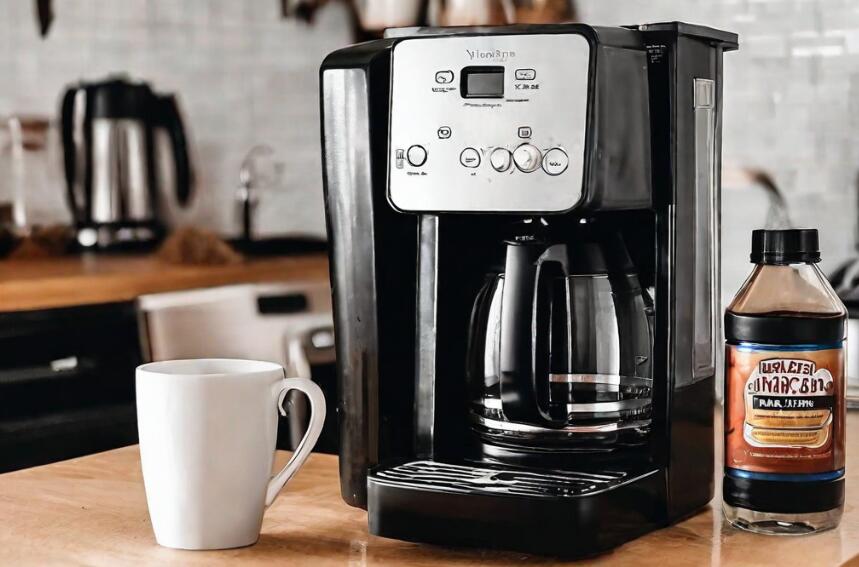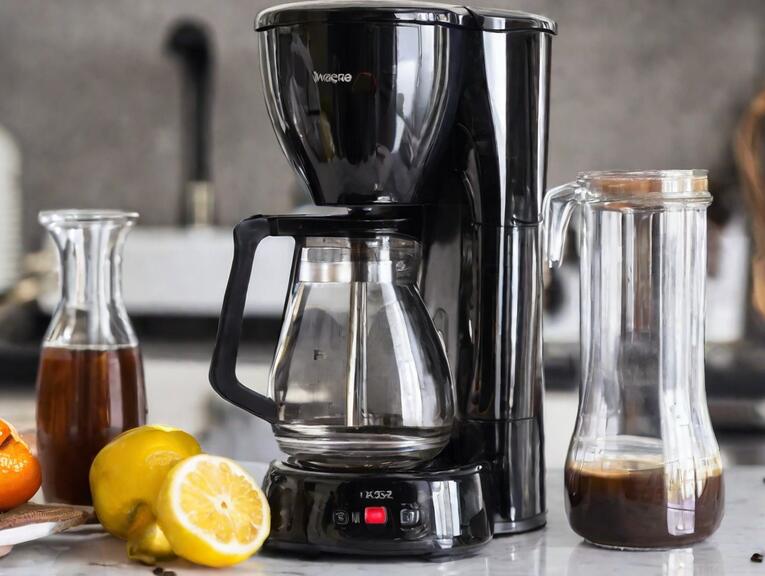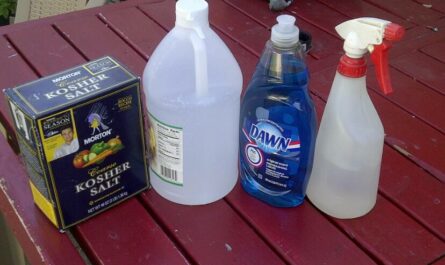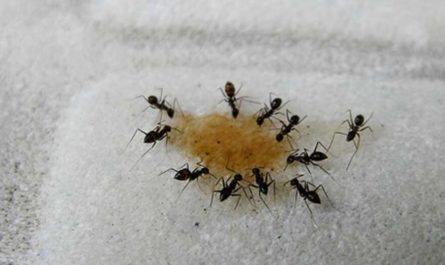If you’re a coffee lover, you know that a clean coffee maker is essential for brewing the perfect cup of joe. Over time, coffee makers can accumulate buildup, residue, and even bacteria that can affect the taste and quality of your coffee. Fortunately, cleaning your coffee maker with vinegar is a simple, natural, and effective solution. In this article, we’ll discuss how to clean your coffee maker with vinegar step by step.
Why Clean Your Coffee Maker with Vinegar?
Vinegar is a versatile and powerful cleaning agent used for centuries. Vinegar’s cleaning power comes from its main ingredient: acetic acid. This mild acid is effective at breaking down mineral deposits, grease, and grime.
When you use vinegar to clean your coffee maker, the acetic acid reacts with the buildup and helps to dissolve it, leaving your machine clean and fresh.
In addition to its cleaning properties, vinegar also has natural antibacterial and antifungal properties. This means that it can help to kill germs and prevent the growth of mold and mildew in your coffee maker.
When it comes to cleaning coffee makers, white vinegar is particularly effective because it:
- Removes mineral buildup and scale from hard water
- Eliminates coffee oils and residue that can turn rancid
- Kills bacteria and mold that can grow in damp environments
- Is natural, affordable, and readily available
Compared to commercial descaling solutions, vinegar is a more environmentally friendly and cost-effective option. Plus, it’s gentle enough to use on most coffee maker models without causing damage.

When to Clean Your Coffee Maker
How often you need to clean your coffee maker with vinegar depends on several factors, including:
- The frequency of use (daily, weekly, or occasional)
- The type of water you use (hard or soft)
- The type of coffee you brew (oily or non-oily)
As a general rule of thumb, it’s a good idea to clean your coffee maker at least once every 3-6 months. However, if you notice any of the following signs, it may be time for a deep clean:
- Your coffee tastes bitter, stale, or off
- Your coffee maker takes longer than usual to brew
- You see visible buildup or residue in the carafe or filter basket
By staying on top of regular cleaning, you can ensure that your coffee always tastes its best and that your machine stays in good working condition.
The Risks of Not Cleaning Your Coffee Maker
If you neglect to clean your coffee maker regularly, you may be putting your health and your machine at risk. Here are some of the potential consequences of a dirty coffee maker:
- Bacteria and mold growth: Coffee makers provide a warm, damp environment that is perfect for bacteria and mold to thrive. If you don’t clean your machine regularly, these microorganisms can multiply and potentially make you sick.
- Mineral buildup: Over time, hard water minerals like calcium and magnesium can accumulate inside your coffee maker, forming a white, chalky substance known as scale. This buildup can clog the water flow, affect the heating element, and make your coffee taste bitter or metallic.
- Rancid oils: Coffee beans contain natural oils that can build up in your coffee maker over time. If these oils are not removed regularly, they can turn rancid and give your coffee an unpleasant taste and smell.
- Decreased performance: A dirty coffee maker may take longer to brew, produce weaker or less flavorful coffee, or even stop working altogether. Regular cleaning can help to keep your machine running smoothly and efficiently.
Step-by-Step Guide: Cleaning Your Coffee Maker with Vinegar
Now that you know why and when to clean your coffee maker with vinegar, let’s dive into the step-by-step process.
1. Preparation
Before you start cleaning, gather the following materials:
- White vinegar
- Water
- Cleaning cloth or sponge
- Soft-bristled brush (optional)
Next, empty the carafe and remove any coffee grounds or filters from the machine. If your coffee maker has a removable filter basket, take it out and set it aside.
2. Cleaning the Carafe and Filter Basket
Start by washing the carafe and filter basket in warm, soapy water. Use a soft-bristled brush or sponge to scrub away any stubborn stains or residue. Rinse the parts thoroughly with clean water and set them aside to dry.
If your carafe has tough stains or odors, you can fill it with a mixture of equal parts water and vinegar and let it soak for 30 minutes before washing.
| Stain/Odor | Cleaning Solution | Soaking Time |
|---|---|---|
| Light | 1 part vinegar, 1 part water | 15-30 minutes |
| Moderate | 1 part vinegar, 1 part water | 30-60 minutes |
| Heavy | 2 parts vinegar, 1 part water | 60-90 minutes |
For really stubborn stains or buildup, you can also try using a mixture of baking soda and water to create a gentle abrasive paste. Apply the paste to the affected areas, let it sit for a few minutes, then scrub and rinse clean.
3. Preparing the Vinegar Solution
To make the cleaning solution, mix equal parts white vinegar and water in a measuring cup or bowl. For a standard 12-cup coffee maker, you’ll need about 6 cups of each.
If your coffee maker is particularly dirty or has a lot of buildup, you can use a stronger solution of 2 parts vinegar to 1 part water. On the other hand, if you’re concerned about the vinegar taste or smell, you can use a weaker solution of 1 part vinegar to 3 parts water.
| Vinegar | Water | Strength |
|---|---|---|
| 1 part | 1 part | Standard |
| 2 parts | 1 part | Strong |
| 1 part | 3 parts | Weak |
4. Running the Cleaning Cycle
Once you’ve prepared the vinegar solution, pour it into the water reservoir of your coffee maker. Then, run a full brew cycle as if you were making a pot of coffee.
Halfway through the cycle, pause the machine and let the vinegar solution sit for 30-60 minutes. This will give the vinegar time to work its magic and break down any stubborn buildup or residue.
After the soaking period, resume the brew cycle and let it finish completely. Once the cycle is done, discard the vinegar solution from the carafe.
5. Rinsing the Coffee Maker
To remove any remaining vinegar taste or smell, you’ll need to rinse the coffee maker thoroughly. Fill the water reservoir with fresh, clean water and run a full brew cycle. Discard the water from the carafe and repeat the process 2-3 more times until the water runs clear and there is no vinegar smell.
If you’re still noticing a slight vinegar taste or odor after several rinse cycles, you can try adding a few drops of lemon juice. You can also run a cycle with a mixture of water and baking soda to help neutralize the vinegar.
6. Cleaning the Exterior
Finally, don’t forget to clean the exterior of your coffee maker. Wipe down the machine with a damp cloth or sponge, paying special attention to the buttons, knobs, and crevices where dirt and grime can accumulate. For stubborn stains or residue, you can use a mild soap solution or a mixture of water and vinegar.
Once you’ve finished cleaning, dry the exterior with a clean towel and reassemble your coffee maker.

Tips and Tricks
Here are a few additional tips and tricks to keep in mind when cleaning your coffee maker with vinegar:
- Use a soft-bristled brush to clean hard-to-reach areas like the spout or filter basket.
- For extra-tough buildup, you can use a stronger vinegar solution or let it sit for longer than an hour.
- If you have a Keurig or single-serve coffee maker, you can use the same vinegar solution to clean the water reservoir and run a cleaning cycle.
- To prevent future buildup, use filtered water in your coffee maker and avoid using oily or flavored coffee beans.
- Clean your coffee maker regularly (at least once every 3-6 months) to keep it in top shape.
- If you have a stainless steel coffee maker, avoid using abrasive sponges or cleaners that can scratch the surface. Instead, use a soft cloth and a mixture of water and vinegar to clean and polish the exterior.
- For a fresh, clean scent, you can add a few drops of essential oil (like lemon or orange) to the water reservoir during the final rinse cycle.
- If you’re short on time, you can also use a quick-cleaning method by filling the water reservoir with equal parts water and vinegar, running a half-brew cycle, and then letting the solution sit for 15-20 minutes before finishing the cycle and rinsing.
Cleaning Other Types of Coffee Makers
While the basic principles of cleaning a coffee maker with vinegar are the same across most models, there are some specific considerations for different types of machines.
1. Keurig and Single-Serve Coffee Makers
To clean a Keurig or other single-serve coffee maker with vinegar, follow these steps:
- Remove the water reservoir and lid, then wash them in warm, soapy water.
- Fill the reservoir with equal parts white vinegar and water.
- Run the machine without a K-cup until the reservoir is empty.
- Let the machine sit for 30 minutes, then run a few more cycles with plain water to rinse.
- Wipe down the exterior with a damp cloth and reassemble the machine.
2. French Press Coffee Makers
To clean a French press coffee maker with vinegar, follow these steps:
- Disassemble the French press and wash the carafe, plunger, and filter screen in warm, soapy water.
- For tough stains or buildup, fill the carafe with equal parts water and vinegar and let it soak for 30 minutes before washing.
- Rinse all the parts thoroughly with clean water and let them air dry.
- Reassemble the French press and wipe down the exterior with a damp cloth.
3. Espresso Machines
Cleaning an espresso machine with vinegar is a bit more involved, but the basic steps are:
- Backflush the machine with a mixture of equal parts water and vinegar.
- Soak the portafilter, basket, and other removable parts in a vinegar solution for 30 minutes, then rinse thoroughly.
- Run a few cycles of plain water through the machine to rinse out any remaining vinegar.
- Wipe down the exterior and steam wand with a damp cloth.
For more detailed instructions on cleaning your specific espresso machine model, consult the owner’s manual or manufacturer’s website.
Conclusion
Cleaning your coffee maker with vinegar is a simple and effective way to ensure that your coffee always tastes its best. By following the steps outlined in this guide and using the tips and tricks provided, you can keep your machine clean, fresh, and free from buildup and bacteria.
FAQs
1. Can I use apple cider vinegar instead of white vinegar?
While apple cider vinegar can be used for cleaning, white vinegar is generally recommended for coffee makers because it has a more neutral flavor and smell.
2. How often should I clean my coffee maker with vinegar?
It’s a good idea to clean your coffee maker at least once every 3-6 months, depending on how frequently you use it and the type of water and coffee you use.
3. Is it safe to use vinegar in my coffee maker?
Yes, vinegar is safe to use in most coffee makers. However, if you have a specialty machine or are unsure, it’s always a good idea to check the manufacturer’s instructions first.
4. Can I use baking soda to clean my coffee maker?
While baking soda can be used for cleaning, it’s not as effective as vinegar for removing buildup and residue in coffee makers.
5. What if my coffee maker still has a vinegar taste after rinsing?
If your coffee maker still has a vinegar taste after rinsing, try running a few more cycles with fresh water until the taste is gone. You can also try using a weaker vinegar solution next time.
6. Can I use this method to clean other kitchen appliances?
Yes, vinegar is a versatile cleaning agent that can be used to clean many other kitchen appliances, such as dishwashers, microwaves, and tea kettles. Just be sure to check the manufacturer’s instructions first and dilute the vinegar with water as needed.
7. What if I don’t have vinegar on hand?
If you don’t have vinegar, you can also use lemon juice or a mixture of water and baking soda to clean your coffee maker. However, vinegar is generally the most effective and affordable option.
8. Can I use this method to clean a reusable coffee filter?
Yes, you can use a mixture of water and vinegar to soak and clean a reusable coffee filter. Just be sure to rinse it thoroughly with clean water before using it again.
9. How can I prevent mineral buildup in my coffee maker?
To prevent mineral buildup, use filtered water in your coffee maker and avoid using hard water if possible. You can also run a cleaning cycle with vinegar more frequently (every 1-2 months) if you live in an area with hard water.
10. What if my coffee maker is still not working properly after cleaning?
If your coffee maker is still not working properly after cleaning with vinegar, there may be a more serious issue with the machine. Consult the owner’s manual or contact the manufacturer for troubleshooting tips and repair options.






